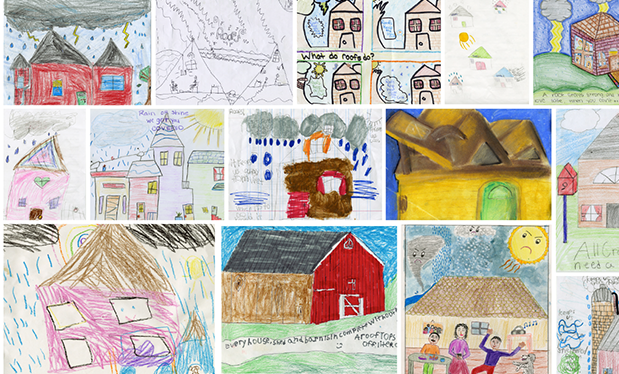The roofing industry has long been viewed by safety agencies and insurance providers as a high-risk segment of the construction market because of its associated fall risks, potential for fire-related injuries and other hazards.
But there is another risk facing construction workers that kills nearly three times as many workers as falls each year—yet it receives much less attention. In 2012, 1,324 construction workers died by suicide, according to the Centers for Disease Control and Prevention (CDC), compared with 544 deaths as a result of "falls to a lower level" in 2012 reported by the Bureau of Labor Statistics.
Sadly, the deaths by suicide in the construction industry usually go unreported, and the issues causing them have been ignored as a health and safety priority. The good news is just as recordable injury and fatality cases have steadily declined during the past decades as a result of improved safety training and preventive measures, so can suicide deaths.
Starting the conversation
The construction industry is at increased risk for suicide. According to the CDC, it ranks No. 1 in the number of suicides and No. 2 in suicide rate at nearly four times the national average among the general population. Roofing contractors, similar to construction contractors in general, have a large portion of their workforce composed of males between the ages of 25 and 54, which are the most at-risk demographic for suicide death, according to the CDC.
Combine that with the high-stress, high-pressure environment of working under strict budgets and deadlines, high incidences of substance abuse and opioid addiction, a "tough guy" mentality, and easy access to lethal means (in and out of the workplace), and this industry is ripe for mental health and suicide crises.
As is the case with any successful corporate initiative, support for change must come from the top. Owners and managers of roofing contracting companies can help employees who may be suffering from a mental illness or are at risk of suicide by taking steps to ensure their companies' cultures exude care and compassion. One of the biggest risk factors for the construction industry is the feeling of shame workers have when revealing a struggle with or asking for help with depression, anxiety, addiction or other mental illnesses. Removing the negative stigma surrounding mental illness is a fundamental step to preventing suicides.
Leaders can make a significant effect on an employee's attitude toward mental illness by sharing stories of hope and encouragement. Perhaps a company leader has struggled with a mental illness personally or with a family member in the past, or he or she knows of someone else in the company or industry who has and is willing to share his or her story.
By sharing personal experiences with employees and co-workers, others suffering in silence can know they are not alone and help is available. When the entire employee population hears respected leaders have not only experienced these issues but also have recovered and gone on to experience success and personal happiness, they will feel more empowered to reach out and start the conversation with others.
Educating employees that mental illness is no different than any other illness and, therefore, should not be treated differently is an important step to helping those suffering or at risk of remaining in the shadows. The fact that one-fifth of the population suffers from a diagnosable, treatable mental illness at any time, according to the CDC, but only 13 percent of those will seek treatment, as reported by the Occupational Safety and Health Administration, shows how critical this education is to helping employees.
As a part of this conversation, employees can be informed of the mental health benefits available through group medical insurance and Employee Assistance Programs (EAPs). Knowing these resources are available not only helps demonstrate these are real issues that should be addressed, it ensures employees understand where they can go for help.
According to Donna Farrell, who works in risk management and human resources for TeamCraft Roofing, Salisbury, N.C., EAPs are good ways to communicate with employees about suicide.
"We use our EAP for all types of counseling services and education for our employees," she says. "We do monthly email blasts to share information about these types of issues. We also conduct toolbox talks addressing depression and recognition of symptoms, and we explain our counseling services can provide assistance to our employees or their families. These services are paid for by the company at no charge to the employee."
Building protective factors
Once the conversation is started, opportunities are created for foremen to watch for and help any crew member who may have a mental health issue or be at risk of suicide and for co-workers on roofing crews to help each other.
Just as members of a crew have been trained to watch out for each other when it comes to ensuring physical safety, the sense of responsibility to keep each other safe from the risk of suicide can be built into crew behavior.
A critical step to making this possible is building peer relationships. Crews that are kept together for extended periods of time likely are not only going to be more productive by having an established routine of doing work, but they also are going to know each other better to notice when something may be "off" with a co-worker. This especially is critical if crews are traveling or working away from home where they also are away from family support systems for an extended time.
When it comes to recognizing and addressing warning signs, educating employees at all levels is critical. A basic understanding of some common behaviors and statements made by those who may be contemplating suicide can be a part of any company's safety training and employee education. Supervisors should be aware of an employee who is increasingly tardy or absent, has an increase in near misses, accidents or incidents, or exhibits decreased productivity.
Management and human resources personnel should be in tune with these performance-related issues, as well, as requests for performance review or disciplinary action related to them should be a trigger to ask questions and examine whether there are underlying causes related to a mental illness the employee is experiencing.
Co-workers may notice a decrease in self-confidence and problem-solving ability, increased agitation or conflict among co-workers, increased isolation, talking aboutfeeling hopeless or helpless, being a burden, being overwhelmed, or wanting to harm themselves to "end the pain."
Employees should be trained regarding who to go to if they see or hear such things and the resources available, such as the National Suicide Prevention Lifeline (800) 273-TALK or Crisis Text Line (text HOME to 741741). At a minimum, all team members should be empowered to speak up and express care and concern for any co-worker they believe could be at risk. Knowing someone cares could be the difference between a suicidal individual getting help or giving up.
What else can you do?
As has been discussed, integration of suicide prevention into the workplace begins with conversations and educating and empowering employees to watch out for one another. These are things that can be done with minimal company investment.
Once your company is committed to addressing mental illness and suicide, you can take the following steps to build a robust prevention program in your workplace.
Have resources in place
Do you have an EAP? If so, do your employees know how to access it and all the available benefits? Educating employees not only about how to use the EAP but also regarding its confidentiality is key—many employees don't know how to use EAPs, and if they do, they are afraid to use them, thinking the information will get back to their employers.
If your company does not have an EAP, find out what mental health benefits are available through your group medical plan (often referred to as behavioral health benefits), and educate employees regarding the benefits and how to access a provider. Even with an EAP and/or group health benefits, some employees will want to start with a completely separate third-party provider. Make information about the National Suicide Prevention Lifeline, Crisis Text Line and local crisis response resources readily available to employees.
Gatekeeper training
Defined as programs that seek to develop individuals' knowledge, attitudes and skills to identify those at risk, determine levels of risk and make referrals when necessary, gatekeeper training creates a clear path for referrals from other employees. Having at least one individual in your company gatekeeper-trained equips your organization for properly dealing with at-risk workers. Gatekeeper-training methods vary from one-hour online to multiday in-person workshops. The QPR Institute, www.QPRInstitute.com, is a good place to start with their "Question, Persuade, Refer" method.
Posters
Available on the Construction Industry Alliance for Suicide Prevention's website, www.cfma.org/suicideprevention, within the Resources tab on the left, there are four poster formats available in English and Spanish that can be downloaded and printed to post in employee break/locker rooms, job-site trailers or job boards, or anywhere else employees gather. These are a great tool for building awareness in a nonthreatening manner and communicating some of the risk factors and warning signs.
Continue the momentum
Two years ago, the topic of suicide prevention in construction was not being discussed. Now, dozens of construction associations, including NRCA, are part of the Construction Industry Alliance for Suicide Prevention, and the resources available for educating all segments of the construction population are growing daily.
When compared with the cost of implementing other safety measures, mental health awareness and suicide prevention can be incorporated into daily safety practices with a commitment to education and building a caring culture. Roofing professionals already are well-trained about the need for safety precautions and protective factors, so suicide prevention easily can be built into existing programs. Rarely is there an opportunity for employers to have such a profound effect on their employees—because of the ripple effect of suicide, this is an opportunity to make a difference not only for your employees but for their families and communities, as well. Make this life-saving commitment today.
Michelle Walker is vice president of finance and administration for Specialized Services Co., Phoenix.
If it happens
Although every safety program aims for zero injuries, procedures exist for handling the injuries that still may occur. Likewise, the goal with suicide prevention is zero suicides, but companies must be prepared to properly handle the suicide of an employee if it happens.
Within the Resources tab at www.cfma.org/suicideprevention is A Manager's Guide to Suicide Postvention in the Workplace: 10 Action Steps for Dealing With the Aftermath of a Suicide. The primary goals in postvention are to demonstrate care, contain the crisis and prevent contagion. The following ACT Model provides a basic process:
- A: Acknowledge the trauma, positioning leaders as also affected by the tragedy
- C: Communicate compassion and competence
- T: Transition the workforce by setting an expectation of recovery and resiliency and helping the workforce achieve a "new normal" and prevention mindset
To help minimize risk of suicide contagion, employers should avoid sensationalizing the death or discussing too many details. Counseling and support resources should be made available while recognizing that affected employees will respond in different ways and desire and require different types of support.
Continue the education
There is so much more to becoming aware of suicide prevention than can be communicated in this article. Two helpful PDF documents are available for download at www.cfma.org/suicideprevention within the Resources tab on the left side of the page:
- Construction + Suicide Prevention: Why is This an Industry Imperative?
- Construction + Suicide Prevention: 10 Action Steps Companies Can Take to Save Lives
These documents are filled with information, links to resources and thought-provoking statements from others in the industry.



